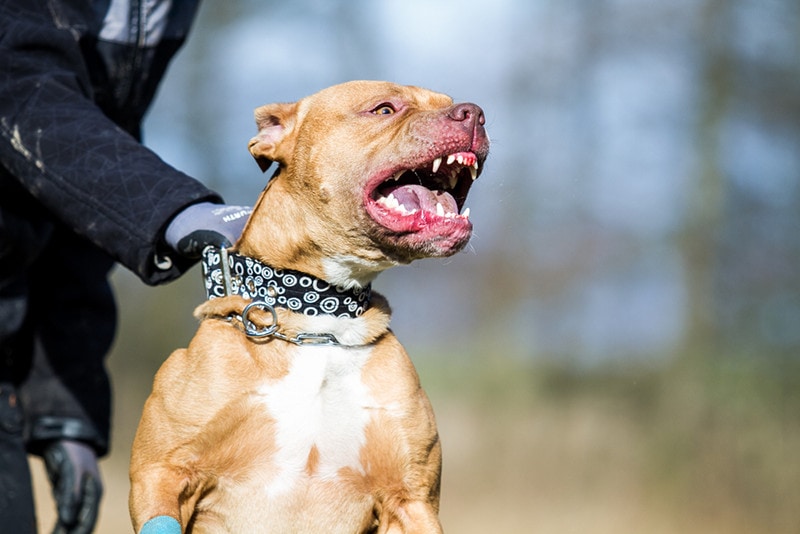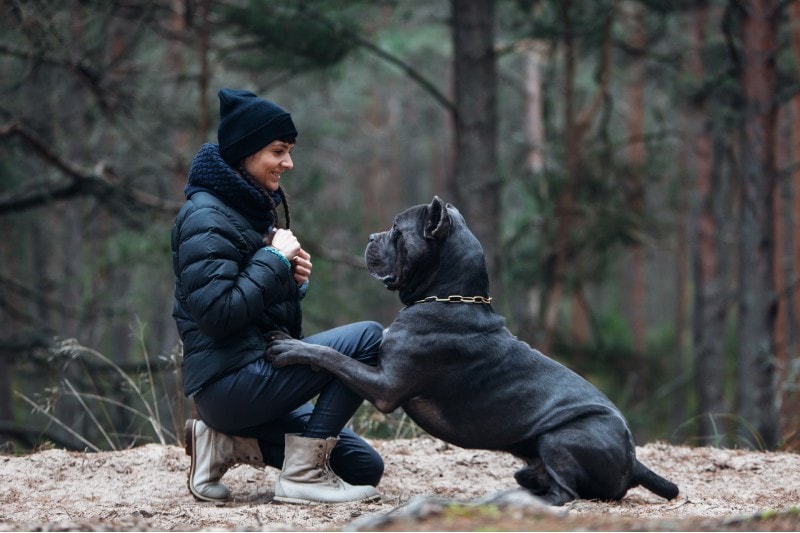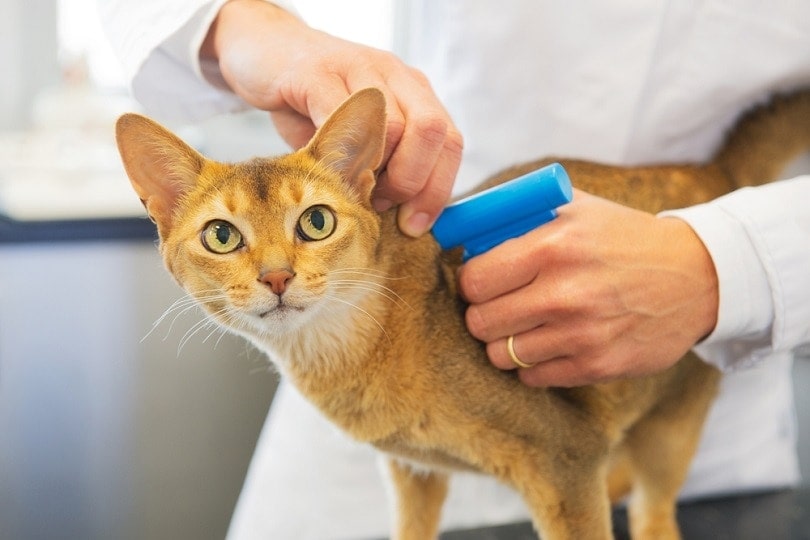How to Stop Aggression in Dogs: 10 Vet-Approved Tips and Tricks

Updated on

Click to Skip Ahead
For most dog owners, dogs are much more than just pets or companions; they’re part of your family. Much like when your child is having problems getting along with other kids at school, your dog exhibiting aggressive behaviors is cause for worry. Once aggressive behaviors begin, they can start to get out of hand pretty quickly if you don’t nip them in the bud right away.
But how exactly do you stop your dog from displaying those aggressive tendencies? The first step is to identify why your dog is getting aggressive in the first place. There’s likely a very good reason, and if you know why, you can use the 10 helpful methods we’ve listed after the types of aggression to stop it. If you follow these steps, you should be able to quickly halt aggressive behaviors in their tracks and get back to the great pooch you love.
How to Stop Aggressive Behavior in Dogs
The first step to deal with aggression is identifying the early signs of aggression or precursors. It is also very important to learn to differentiate the types and causes of aggression that dogs might exhibit. Feel free to learn more about this by jumping to the next section of this post. Once you have identified the possible causes and the precursors, it’s time to start discussing solutions. When your dog is being aggressive, there are several steps you can take to fix it before the problem gets out of hand.
1. Remain Calm

One of the most important things you can do is remain calm. If you respond to aggression with more aggression, what do you think you’ll get? Right, more aggression. So, when your dog begins to display those aggressive tendencies you want to curb, it’s vitally important that you remain completely calm.
Also, remember that dogs feed on your energy. Whatever energy you’re displaying, your dog will likely copy. So, if you’re displaying aggressive behaviors, even if you don’t realize it, your dog will be mimicking those same behaviors. Ensuring that you stay calm, loose, and relaxed will also help to keep your dog calm and will at the least ensure that you’re not exacerbating the problem.
2. Check Your Surroundings

Often dogs are being aggressive for a good reason. Maybe there’s something nearby that your dog is aware of but you aren’t. If you can’t pinpoint the exact reason your dog is being aggressive, take a look around and see if maybe something is out of place. There could be a person or animal nearby that you haven’t noticed, but your dog’s heightened sense of smell might have alerted it to their presence.
3. Remove the Source of Your Dog’s Aggression

If your dog is becoming aggressive around or because of a single thing, you can simply remove what’s causing your dog’s aggression. For instance, if your dog becomes aggressive only when it’s around certain other dogs or people, then you might start by simply separating them. This is a temporary fix, of course, but it can be a great way to stop the aggression immediately so you can take other actions when time permits.
4. Prevention

If you know certain situations could be difficult for your dog, you might be best off avoiding them. For example, if your dog always gets scared when your friend brings their dog around and this causes aggressive behaviors, don’t have your friend bring their dog around again. If your dog gets aggressive when playing certain games, then maybe those games aren’t the best fit for your dog.
Unfortunately, sometimes, situations aren’t as fixable as we like. If your dog is constantly aggressive towards your kids and you can’t seem to cure it, then it may be time to consult a professional animal trainer or consider rehoming your dog to a household with no children. While it might be heartbreaking, it’s also in everyone’s best interest.
5. Check for Medical Conditions

If your dog has suddenly started exhibiting aggressive tendencies when that’s not their usual temperament, then something else might be going on. Your dog may have some unknown underlying condition. This could be making them uncomfortable, causing pain, or worse. Some neurological disorders can also result in behavioral changes. While you can’t diagnose these yourself, your vet should be able to help.
6. Refrain From Punishing

As we mentioned, aggression creates more aggression. If you react to your dog’s aggression with a stern voice and a punishment, it can cause your dog to be even more aggressive, making the whole problem worse.
Also, consider that many of these aggressive behaviors are warning signs. If your dog growls at your child, it’s a warning that your dog isn’t comfortable with whatever the child is doing. But if you decide to punish your dog for the growling, then your dog might skip the growling next time and simply react. This could mean your child getting bit, which will create much bigger problems for you and your dog.
7. Positive Reinforcement

So, if you shouldn’t punish your dog for their aggressive behaviors, instead, reward them for their good behaviors! If your dog becomes aggressive, wait for them to calm by remaining completely calm. Once your dog calms down a bit, redirect them and ask for a simple behavior, such as “sit.” If the dog follows the command, heap positive praise on them. Positive reinforcement is the most effective way to let your dog know that being calm has many advantages.
8. Proper Socialization

A lot of these aggressive behaviors come down to poor socialization. For dogs, socialization is extremely important. You should be exposing your dog to as many other pets and people as possible. This should begin at an early age and continue all through life. Dogs that haven’t been properly socialized will often react aggressively out of fear in social situations.
Of course, you can start socializing your dog at any time, as long as they have completed their vaccination schedule. Just have other people and pets come over to your house or bring your dog to other places where there are plenty of new people and pets for them to meet. Keep them on the leash and start slowly. Begin with a single pet or person and introduce them carefully. Let your dog get used to the new person and slowly become acclimated. Then, you can start introducing more people and animals until your dog is comfortable meeting strangers.
9. Training

A lot of times, the aggression that’s caused by fear can be stopped with proper training. Good training will make your dog more confident in themselves and in your leadership, which can result in a much less fearful dog. You can train your dog yourself with basic obedience commands or you can take them to obedience classes where you’ll be able to learn alongside other dogs and people. This can be a great way to socialize your dog while getting that much-needed obedience training.
10. Get Professional Help

Sometimes, the problem is simply beyond your ability to control. In these extreme cases, it’s time to call in a professional. You could try a professional dog trainer or an animal behavior specialist. Either one should be able to help you pinpoint the exact problem you’re experiencing. Then, together, you’ll be able to come up with an action plan to finally end all of the aggressive behaviors once and for all.
Early Signs of an Aggressive Dog
When your dog starts to become aggressive, you must take steps to make the behavior cease immediately. This requires spotting these behaviors before they grow into anything less manageable. The earlier you catch these warning signs, the easier it will be to curb aggressive tendencies.

Luckily, there are plenty of signs that can clue you in to your dog’s growing aggression before it gets out of hand. These early signs are called precursors.
- Growling
- Baring teeth
- Snarling (Growling and baring teeth simultaneously)
- Light biting without pressure
- Nipping
- Loud, guttural barks
- Lunging at people or animals
- Biting
The moment you see any of these behaviors, it’s time to take action. Though some of these may seem harmless, they can lead to much bigger aggression problems if left unchecked.
Different Types of Dog Aggression
Recognizing your dog’s aggression is the first step toward stopping it. The next step is to understand it. This could be a bit harder than the first step. Identifying aggression is easy; just look for certain unwanted behavior patterns. But identifying why your dog is aggressive is harder since you can’t just ask them!
As it turns out, dogs can become aggressive for quite a few reasons. Your dog can display as many as 11 different types of aggression depending on what’s causing them to act out. Each of these types of aggression has its own root causes that must be identified if the behavior is to be stopped.
Possessive
Possessive aggression is when your dog becomes aggressive to protect something it perceives as valuable such as food, a chew toy, a ball, or anything else. This is also called resource guarding.
Protective
This is when a dog gets aggressive to protect a member of its pack or family. This is most common in mothers who can be very protective of their young, though any dog can become aggressive when being protective of their loved ones.

Fear
If a dog is overwhelmed with fear, it may feel that aggression is the last resort. In this case, it’s not uncommon for dogs to growl, bite, or even attack.
Territorial
This is when a dog becomes aggressive to defend its space from an intruder.

Defensive
This is when a dog attacks as a defense mechanism without trying to leave the situation first. Usually, these dogs give other less obvious warning signs before biting.
Social
This is when dogs react aggressively towards other dogs, pets, or people in social situations. Most often, this is simply because a dog hasn’t been socialized enough.

Redirected
Redirected aggression is when the dog is aggressive towards someone they weren’t initially being aggressive towards. For instance, when you stop a fight between two dogs and one redirects their anger towards you, or when two dogs are on opposite sides of a fence and can’t reach each other so one dog becomes aggressive towards another pet or person on their side.
Pain Response
Pain response aggression is simply an aggressive response to physical pain or injury.
Sex-Related
When two dogs of the same sex are competing for the attention of the same mate, it can lead to aggression and even fighting. This is easily mitigated by spaying and neutering.
Frustration
When a dog is too restricted, they may act out in frustration. This is often the case for dogs that are restricted by a leash and cannot reach their target. This form of aggression is similar to redirected aggression, but it includes some form of physical restriction.

Predatory
This is when a dog’s natural prey drive takes over. It can happen with wild animals, domesticated pets, or even children.
Conclusion
If your dog starts becoming aggressive, it can be very scary as their owner. You’re suddenly unsure of how your dog will behave and what will happen to them in the future. But if you take the time to understand your dog’s feelings and learn what’s causing them to act aggressively, you can take steps to fix the issue and ensure your dog’s aggression falls by the wayside. Just follow the 10 methods we’ve outlined and you’re sure to have your dog behaving well in no time.
See also:
- 10 Best Puppy Training Treats – Reviews & Top Picks
- How to Manage an Overprotective Dog: 7 Vet-Reviewed Methods
Featured Image Credit: wahrnehmer, Pixabay













